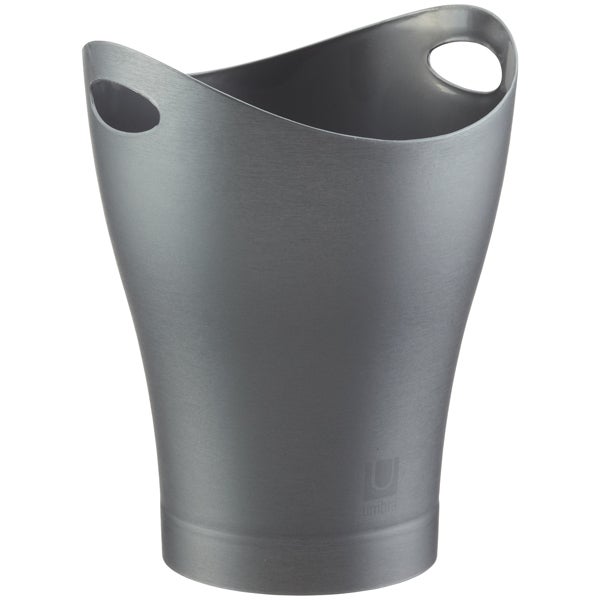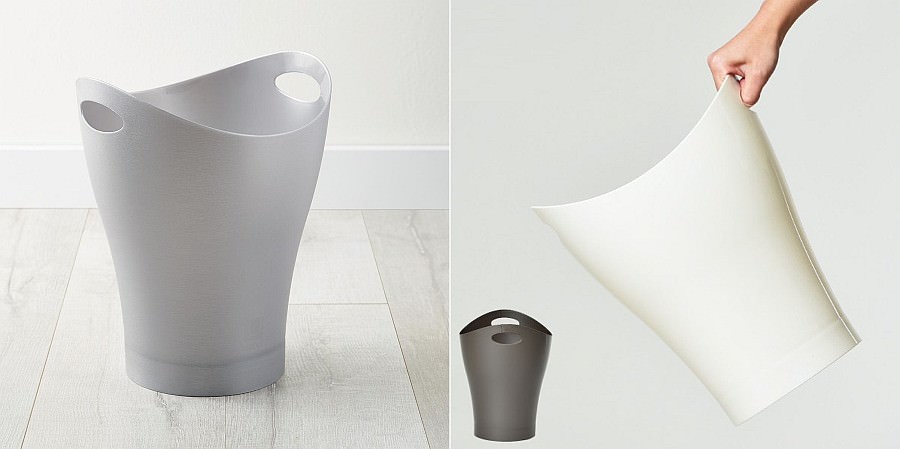Karim Rashid emerged in the 1990s as a designer who wanted to democratize beauty: inexpensive, mass-produced objects that look optimistic, fluid and human-centred. He blends a pop sensibility with industrial techniques, aiming to make everyday items desirable rather than hidden. The Garbo waste can — later offered in a smaller Garbino version — is one of the clearest expressions of that mission: a simple domestic object rethought as a sensual, inexpensive icon.
Product snapshot — what Garbo is
Garbo (sometimes referenced as Garbino for the smaller variant) is a polypropylene wastebasket designed with a continuous, curving silhouette and an upturned rim that doubles as a carrying handle. It’s lightweight, inexpensive to manufacture, stackable and available in bright colors as well as translucent and matte finishes — all choices that make it suitable for mass retail and everyday life. The can’s sculptural rim and negative-space gestures turn functional geometry into a distinct visual signature.

Why the idea mattered — reframing the ordinary
Before Garbo, trash bins were utilitarian, hidden or visually forgettable. Rashid’s proposition was audaciously simple: if people live with objects every day, why not make those objects pleasurable to look at and touch? Garbo reframes waste management as a small act of daily delight. This reframing made the product more likely to be left on display instead of tucked away — an important change in how consumers relate to ordinary objects.
Designer mindset — democratic design and visual optimism
Rashid’s mindset on Garbo combined three guiding convictions: design should be optimistic (use color and curve to lift mood), it should be accessible (low-cost production and broad availability), and it should be honest about material (playful use of inexpensive polypropylene rather than pretending to be a luxury material). He approached the brief anthropologically — studying how people actually use small cans in dorm rooms, bathrooms and offices — and then pushed the form language until the can read like an emotive object rather than a mere receptacle.

From sketch to product — the development process
The Garbo development path is a textbook example of industrial-design pragmatism married to conceptual clarity:
Problem framing. Identify how, where and why small wastebaskets are used (under sinks, beside desks, in bathrooms) and list the practical constraints (stacking, low production cost, ease of cleaning).
Form exploration. Rapid sketches and maquettes explored various rim profiles and body tapers; the winning silhouette emphasized a continuous curve that worked as a handle and as a visual flourish.
Material selection and tooling. Polypropylene was chosen for cost-effectiveness, flexibility and mouldability. Rotational/injection moulding tooling was developed to create a single seamless shell with consistent wall thickness.
Prototype & user testing. Early samples validated stacking behaviour, rim ergonomics for emptying and the way translucency or color changed perceived weight.
Production ramp. Tooling and process controls were finalised to ensure repeatable parts suitable for large retail orders, keeping unit cost low while maintaining the expressive rim profile.
This loop — brief, form, material, prototype, production — kept the project focused on mass appeal without diluting its sculptural intent.
Manufacturing notes — how Garbo stayed cheap and iconic
Garbo’s success is partly technical: the design was optimised for efficient injection/rotational moulding, which allowed one-piece production with no seams. Wall thickness, draft angles and stack tolerances were tuned to reduce scrap and to enable automated packing. Color and finish options were applied without extra assembly steps, and the handle-like rim served a twofold function (use + identity) so no additional features inflated cost. The result: a visually distinctive object that could be produced and sold at very low price points.

Prototyping challenges and solutions
Turning a seductive sketch into a functional bin revealed practical challenges: rim comfort (sharp edges would dig into hands), drainage (rounded bottoms help avoid trapped liquids), wall resilience (thin walls must resist cracking when lifted full) and stackability (preventing jamming while maximising shipping density). Each issue was solved through minor geometry tweaks, material-grade choices and tool calibration — small engineering moves that kept the form intact while making the object robust for everyday use.
Reception and cultural impact
Garbo quickly became more than a retail object: it circulated in design press, entered museum collections and became a shorthand for Rashid’s ethos. Its broad popularity (millions sold across variants) proved that carefully designed, low-cost items can have cultural resonance equal to high-end design. Museums and design libraries have collected Garbo as an example of late-20th-century democratic design — a sign that good design can be for everyone.

Why juries and curators noticed the piece
Awards and curatorial interest tend to look for novelty, cultural commentary and manufacturability. Garbo scored on all counts: it used humble materials in a fresh way, made an argument about everyday aesthetics, and met the practical criteria of mass production. That marriage of concept and commerce is central to why the can was included in permanent collections and written about in major design outlets.
Variants, branding and product family thinking
Umbra and other licensees extended Garbo into Garbino and other sizes, translucencies and colors, turning it into a family rather than a single SKU. That move multiplied retail opportunities and allowed the design to live in varied contexts (bathroom, kitchen, office). The family strategy also helped maintain relevance across seasons and markets without changing the core geometry that made the design recognisable.
Sustainability and lifecycle — practical notes
Because Garbo is made from thermoplastic, its sustainability profile depends on materials and end-of-life strategy. Advantages include light weight (lower transport emissions per unit) and long life if the plastic resists UV and cracking. Downsides are the usual ones for mixed plastic waste streams: recycling depends on local facilities and the product’s polymer grade. From a design perspective, Garbo demonstrates that low-cost consumer objects can be built to last and be easy to clean — two important sustainability wins for mass-market items.
Design lessons from Garbo — practical takeaways
Design the humble things well. Everyday objects offer the largest scale impact if they’re beautiful and affordable.
Form + function = identity. A single distinguishing formal move (the Garbo rim) can become a brand signifier.
Prototype for manufacture. Early attention to tooling and tolerances preserves design intent through mass production.
Extend thoughtfully. A family of sizes and finishes multiplies impact without diluting the idea.
Curation matters. Placement in curated contexts (museums, press features) turns a household object into a cultural emblem.



